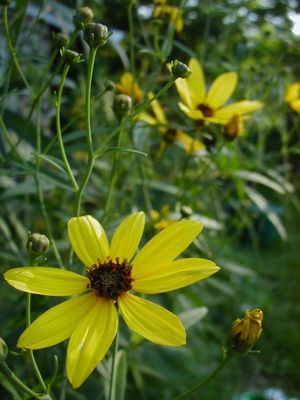Coreopsis tripteris
Tall Coreopsis

This coreopsis is the last one to bloom. It is easily grown in dry to medium wet, well-drained soil in full sun. It can also thrive in poor, sandy or rocky soils but will produce shorter plants that are open and somewhat spindly. Plants grown in medium wet soils with consistent moisture tend to be taller and fuller. Tolerant of heat, humidity and drought.
Noteworthy Characteristics:
Tall coreopsis or tall tickseed is a tall, slender Missouri native wildflower which typically grows 4-8' tall and typically occurs in prairies, dry open woods and wood margins, and along roadsides and railroad tracks throughout the state. Features solitary, yellow, daisy-like flowers (1-2" diameter) with eight yellow rays (rounded and untoothed at the tips) and flat brown center disks. Flowers bloom atop slender, erect stems from mid to late summer into fall. Stalked, anise-scented stem leaves are tripartite (divided into three narrow lance-shaped segments). Plants in the genus Coreopsis are sometimes commonly called tickseed in reference to the resemblance of the seeds to ticks.
Additional Information:
Height
2-8 Feet
|
 |
Spread
2-8 Feet
|
|
|
 |
Bloom/Seasonal Color
Yellow
|
USDA Hardiness Zone 3-8
Home Owner Growing and Maintenance Tips:
Prompt deadheading of spent flowers may encourage additional bloom and prevents any unwanted self-seeding. Freely self-seeds, and in optimum growing conditions will naturalize to form large colonies. If grown in borders, division may be needed every two to three years to maintain robustness.
Characteristics & Attributes
Hydrologic Designation
|
Root
|
Season of Interest
|
Soil Moisture
|
Sun Exposure
|
USFS MO Ecological Map
|
Wildlife Benefit
|

